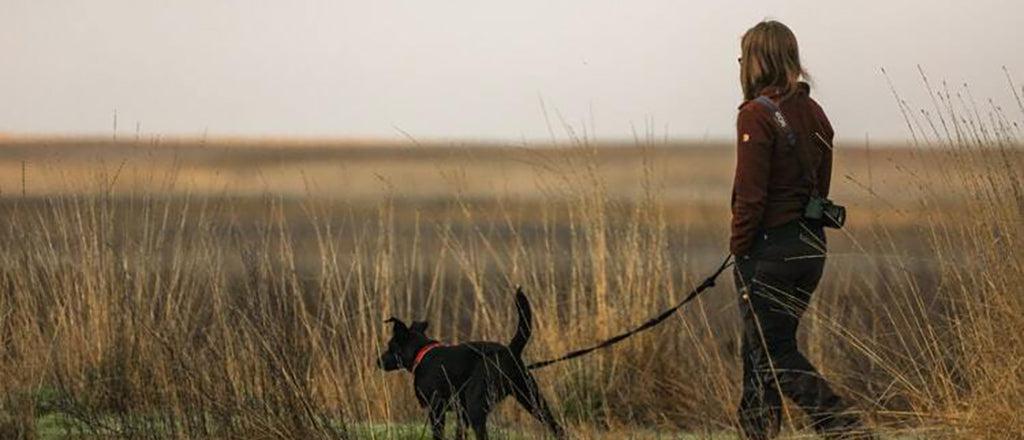If your dog’s pulling on their leash, there are steps you can take to help them stop. Learn why dogs pull on leashes and whether a harness or a collar is better for dogs that pull too.If your dog’s pulling on their leash, there are steps you can take to help them stop. Learn why dogs pull on leashes and whether a harness or a collar is better for dogs that pull too.
How To Stop A Dog From Pulling On The Leash

Wondering how to stop your dog from pulling on the leash? Constant leash pulling can turn an enjoyable walk into a battle of wills! The good news is, no matter how young or old your pup may be, they can learn that walks are much more enjoyable without the tugging with a little training and patience.
Why Does My Dog Pull On The Leash?
Generally, when your dog pulls at the leash it means they’re excited to hit full stride and run about, which is completely normal. With all the new sights and smells, it can cause them to become overly curious and SO excited to go out and explore them all. This means that pulling shows they’re happy and naturally curious, so the reason they’re doing it is usually nothing to worry about. They may have also simply associated that by pulling they get to move forward!
However, if your dog is lunging or barking when they’re on the leash, it could mean that they’re scared of something nearby and they’re trying to protect themselves or get away. If the latter is the case, then it’s time to focus on making walking a positive experience and start rewarding them when they exhibit calmer behavior.
Does Pulling On The Leash Hurt My Dog?
It doesn’t usually hurt your pup when they pull, even if it makes them cough a little, so don’t be afraid to stand your ground. Do avoid sharply jolting the leash though, as this can hurt them and make them jump, and you don’t want your pooch to associate their walking gear with pain or become scared of the collar, leash, or you.

Stop Dog From Pulling On Leash
If you have a dog that pulls on the leash, find a quiet area, with limited distractions to start your leash training.
To begin with, when out on your walks, as soon as the leash begins to tighten, you should stop walking, stay calm, expressionless, and keep quiet. Once the leash becomes slack again, continue walking. This will help your dog associate that they get to walk when they’re not pulling instead of vice versa.
Moving forwards, whenever they walk next to you on a loose leash, reward them! You’ll probably need several treats to start and then gradually you can reduce and reduce until they’re fully trained. To avoid stopping and starting, try to treat whilst you’re both moving next to each other.
To make sure your dog doesn’t gain too much weight during training (which can be detrimental to their joints and health), make sure to use treats that are high in lean protein, so they’re lower in fat. Also, check the label and be sure that they have a minimal amount of ingredients which should mean they shouldn’t contain any hidden nasties either! It’s easy to over treat when rewarding good behavior, so choosing your treats wisely will help keep your pup’s weight and health in check.
PetLab Co. Pro Tip: You could try cooking up small pieces of lean, grilled chicken, pieces of cucumber and segments of apple (minus the pips!) as biscuit alternatives when rewarding good behavior on the leash. This will help with their fiber levels too!
And remember, be consistent with your training. Repeat this process every time you are out with your pup. Initially, walks will take longer whilst they are learning but before you know it, they’ll be a walking like a pro!

Dog Harness Vs Collar: Which is best?
If your dog is struggling to learn to behave on just a collar and leash, a harness may be a great route for you to take when it comes to dog harness vs collar!
A body harness can help discourage pulling as they help prevent doggos moving as far forward when they pull. Harnesses also help give you more control, particularly in busy areas like cities and in crowds, but also over larger breeds as it takes less of a toll on your arm and back strength. Harnesses are also considered safer, as they disperse pressure over a larger area of your pooch’s body, which reduces the amount of strain exerted on their neck.
With puppies, a harness can also prevent them from getting tangled up in their leash as they learn to be on one! It’s definitely something to research and consider.
If your dog is happy in a collar, do not be tempted by choke or prong collars that are designed to constrict or cause discomfort as a mean of training. These are cruel, painful and just cause a dog to be scared of them and you. They do not induce good behavior. Only positive reinforcement via treats and praise can do that effectively and get a dog to stop pulling on the leash.
 S
S



